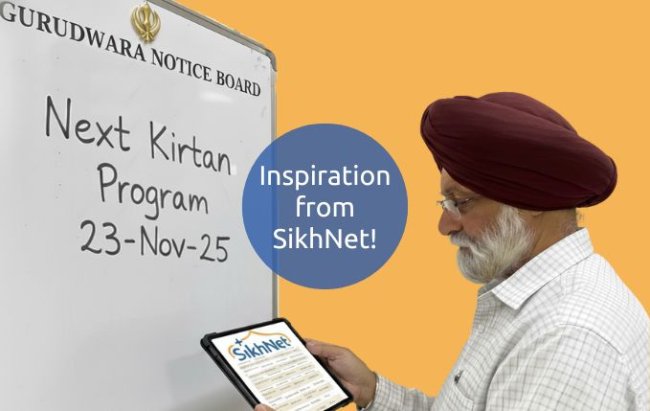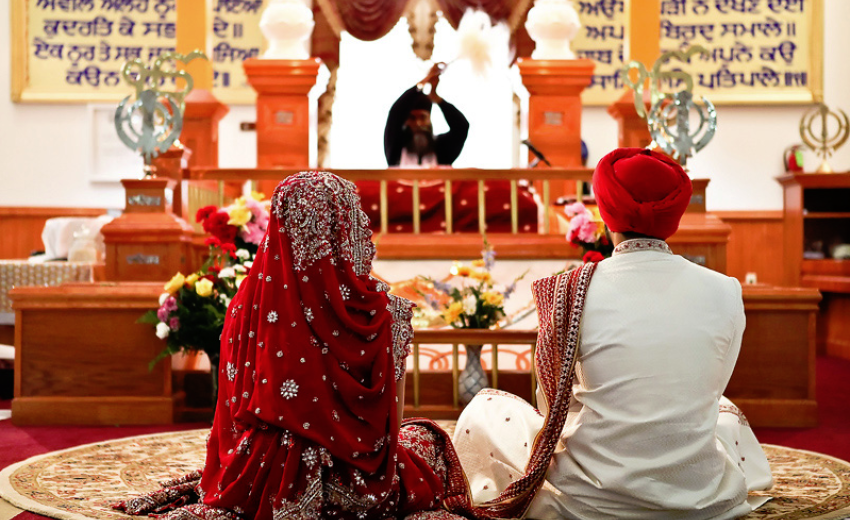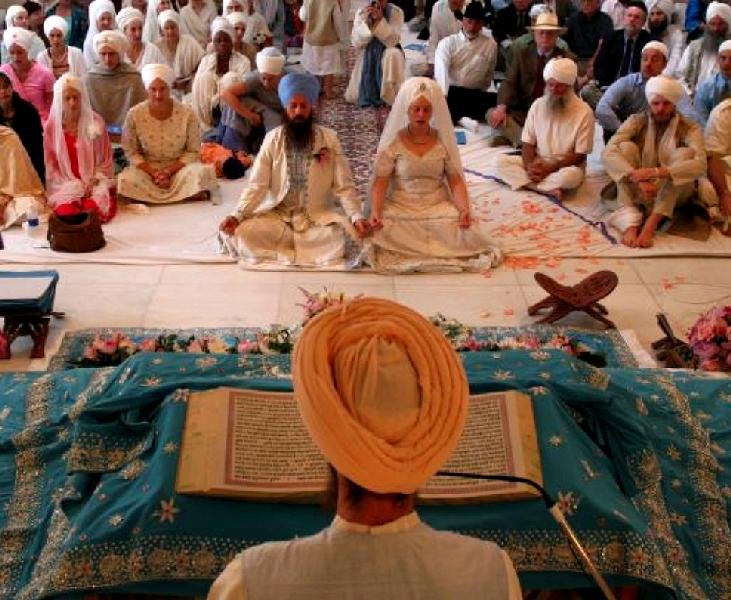
It is amazing that it took quite awhile for me to appreciate the significance of the Sikh marriage ceremony called the Anand Karaj. A non-Sikh once asked me the meaning of the Second Lavan and I had to conjure up my thoughts to give him an informative response. This never actually came about since we were in the midst of the usual hurry with the marriage ceremony.
After some time, he mentioned that he knows it now and I presume he must have asked someone else who had the time to explain it to him with great devotion and pride. I was impressed by his eagerness to know and feel that this should be the case with others.
The Anand Karaj is conducted in the presence of the Sri Guru Granth Sahib Ji and it is a sacred ceremony that binds a man and woman in a spiritual union; the spouse is a companion and life partner with whom to tread the divine path of Sikhi.
The bond between those blessed couples grows so strong by His Grace that they become One Light (Soul) in two bodies. According to Sikh philosophy within the heart there are two souls, the Atma (Bride) and the Param-atma (The Groom); the atma is a fragmented portion of the Param-atma, liken to the finger and the finger-nail, it is One. Our Goal is to embrace face to face with Waheguru in Sachkand, the Bride and Groom as One. Marriage is both a social and religious occasion. Nowadays it seems that allowing the couple to choose each other irrespective of caste and other demands placed by both families should be the way forward.
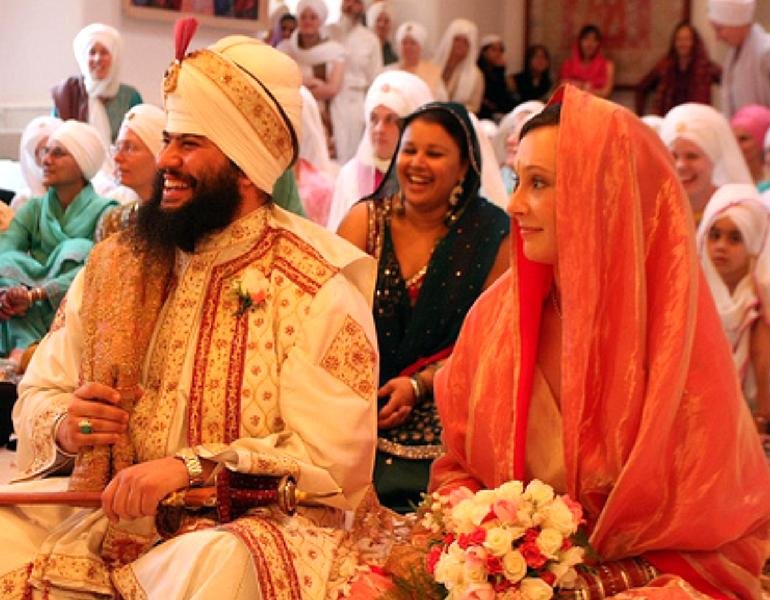
The Lavan is the core of the Anand Karaj (the 'Ceremony of Bliss') which includes the singing of shabads whilst the couple circumambulates (circles) the Guru. It provides the couple with foundational principles of a successful marriage but places the union within the deeper context of union with God. Guru Ram Das Ji, the Fourth Guru of the Sikhs composed the four stanzas, Lavan to be sung and recited as the core of the Anand Karaj.
In 1579, Guru Arjan Dev Ji and Mata Ganga had the unique honour of being the first couple to be wedded with the Anand Karaj.
The Sikh tradition has been continued since then and I am concerned that in the present time, the Anand Karaj be given its respect and recognition as the core and the main priority of the Sikh ceremony.
It appears from recent Diaries by Bhai Dya Singh Ji that the focus of marriage ceremonies has shifted to glamorous and lavish receptions and celebrations, away from the Gurdwara the doorway to the Guru. Recently, I attended an Anand Karaj in Nottingham, UK where the ceremony was done very swiftly and even during the Ardas, many members in the congregation had their hands in their pockets just impatiently waiting, it seemed to me, for the auspicious occasion to finish so that they could dash off to the Party Hall to have their food and drink. One even approached me with a smirk on his face, to ask exactly how long the ceremony would take and so on. This did not shock me particularly in these times of the Kalyug where the living souls have fallen prey to the five vices.
'Karaj,' derived from the Sanskrit word 'karya' means literally a work or undertaking or in a more solemn sense, it means 'ceremony.' 'Anand' literally means bliss or ecstasy.
The marriage ceremony begins with the arrival of the Barat or the bridegroom at the Gurdwara.
Marriages have been held in hotels and banqueting halls which really is against the spirit of Sikhi since a sacred ceremony should be performed in a sacred place; such practices are against the Akal Takhat Hukamnama.
The bride's parents and family wait at the entrance of the Gurdwara and the bridegroom stops a few steps away. The following shabad is then recited from Raag Suhi Mahella 1 (composed by Guru Nanak Dev Ji) - Hum ghar saajan aye. ("Friends have come to our home; The True One has brought about this meeting. Through love have we met by God's Grace, and we are filled with joy to meet these good souls. Thus have we attained that for which we yearned. Our wish is to meet in this way every day. My home is blessed. Music is sounding within me for Friends have come to our home.")
After the shabad has been recited, ardas is offered. Then the milni (informal family meeting) takes place and the barat is taken into the Gurdwara. The party proceeds into the Darbar Sahib where the Sri Guru Granth Sahib Ji is enthroned on a decorated palanquin. The bridegroom, now joined by the bride, firstly bow to the Guru and then sit in front of the Sri Guru Granth Sahib Ji for the ceremony to be conducted by the Raagis and the Granthi.
At the outset, the following shabad is recited from Sloka in Raag Sri composed by Guru Nanak Dev Ji: Kita lodiye kam so Har pai akhiye: To seek success in any undertaking, request the blessing of God. By the Grace of His teaching, your objective will be fulfilled. In the company of the Holy, drink the nectar of goodness. Oh dispeller of fear, protects Thy servant. Sayeth Nanak, by singing His praises one may experience the Infinite Lord.
The actual ceremony begins with the offering of a special ardas by only the bride and groom and their respective parents whilst the rest are seated. Upon the completion of the ardas, the couple and their parents bow to the Sri Guru Granth Sahib and sit down and prepare for the bliss ceremony to unfold.
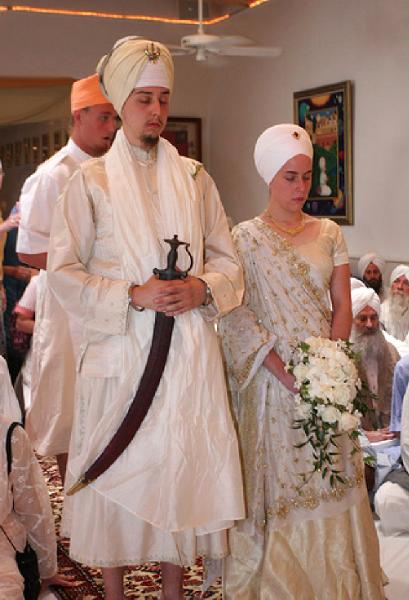
Thus begins a series of golden moments, full of love and sacredness. The Granthi takes the vak - that is reciting the first shabad on a page opened at random, which invariably dictates the personal message of the day as well as for the rest of the life of the couple. Some of them do not even understand or take heed of this Hukamnama which is the Guru's personal communication to the couple. After the vak, the bride's father takes the palla or shawl, and places in the hands of the daughter. This can be very emotional as the father knows that he is giving his daughter away and that she is departing from his care and tears start welling in the eyes of the parents. This action is accompanied by the following sloka in Raag Ramkali composed by Guru Arjan Dev Ji; Ustat ninda, Nanak, ji mai hab vanjayi chodiya hab kichh tiyagi, Habay sak kudavay ditthe tau pallai tende laagi. ("I have become immune to praise and criticism, Oh Nanak, and have renounced attachment to things of the world having seen that worldly attachments are false. Knowing this, I hold on to your shawl.")
The next stage is the Lavan itself - the four marriage vows in verse form.
The Four verses of the Lavan are recited from the Sri Guru Granth Sahib Ji and then sung as the Anand Karaj takes place. These verses were composed by Guru Ram Das Ji, in the measure of Suhi in the form of Chhants.
'Lavan' literally means 'break away' since the bride is breaking away from her parents' house and uniting with the husband's family. The verses of the Lavan describe the aspects and stages of marital love between the husband and wife, as the marriage of two people in the unity of two souls rather than just a physical relationship.
In spiritual terms, the Lavan is about the union of the human soul, the Atman, with God, Parmatma. In worldly terms, the four hymns of the Lavan are the four vows of the marriage. Each verse is first read by the Granthi, the Raagis then sing it in the form of kirtan. It is good to have a Raagi Jatha who with his melodious voice, has the ability to explain the lav clearly and keep the interest of the congregation in high spirits. During the singing of each verse, the couple bows to the Sri Guru Granth Sahib Ji, and then gets up and walks around(clockwise) the Guru, and at the time they arrive back at their seats in front of the Guru, the singing of the verse is complete. This is repeated for the second, third and fourth round, and each time the couple bows to the Sri Guru Granth Sahib Ji. Close brothers and nephews form a half circle around the Guru to guide the bride and give her all the support they can muster. It is all Guru Ji's Grace for this momentous occasion.
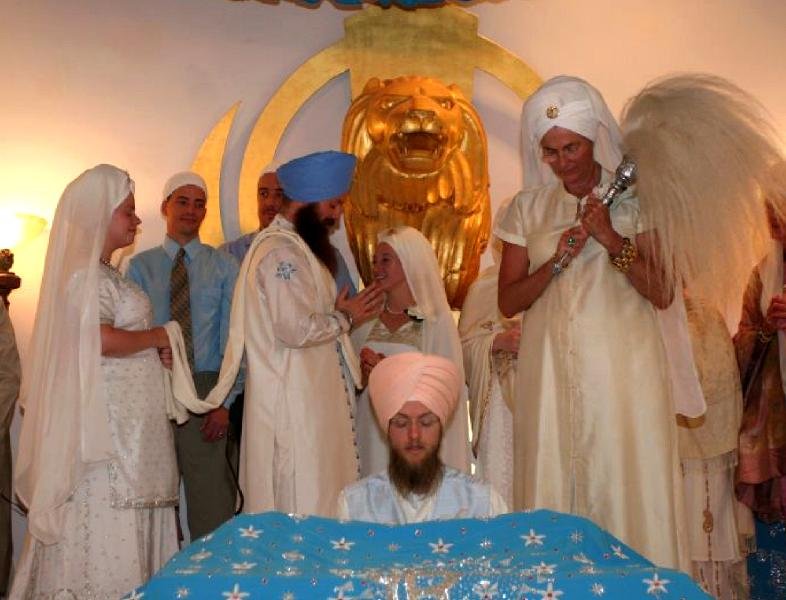
"In the first round of the marriage ceremony, the Lord gives you His instructions for married life. Instead of performing rituals by routine, embrace the righteous life of Dharma, and do nothing that separates you from God. Meditate on God’s Name. Embrace and practice Simran - the continuous remembrance of your True Identity. Worship and adore the Guru, the Perfect True Guru, and all the errors of your past shall be washed away. By your great destiny, you shall know that bliss which passes all understanding, and the Lord - Har, Har, will become sweet to your mind. Servant Nanak proclaims that in this first round, the marriage ceremony has begun."
The first verse of Lavan is about letting go of the past and embarking on a new beginning. It stresses that the center of the marriage is spiritual and that the success of the marriage rests on the couple having a daily spiritual practice.
The second verse is, "Har doojdi lav Satgur purukh milaya Bal Ram jio...."
"In the second round of the marriage ceremony, the Lord guides you to meet the True Guru - the One Teacher. Filled with the awe of the Infinite, your ego dissolves away. In awe of the One who is forever pure, sing His Wonderful Praises and see God in all. The Lord - the Supreme Soul, is the Master of the Universe. He fills everything, everywhere. He fills all spaces. Deep within you, and outside you as well, see only One God. God’s humble servants meet together and sing the songs of joy and ecstasy. Servant Nanak proclaims that in this second round, the music of the spheres resounds."
The second verse states that the Guru is the centre of the marriage and that such a marriage is filled with joy and ecstasy.
The third verse is: "Har teejdi lav man chao bhiya bairagiya Bal Ram jio...."
"In the third round of the marriage ceremony your heart is filled with Divine Love. By my great destiny I have met the humble Saints who love the Lord and I have found God. I have found the pure Lord and I sing His Wonderful Praises. I sing the Guru’s Bani. By great good destiny I have found the humble Saints and I speak in the silent language of the Infinite. The Lord’s Name - Har, Har, Har, vibrates and resounds within my heart. Meditating on God, I have realized the great destiny written on my forehead. Servant Nanak proclaims that in this third round, the heart is full of Divine Love of the One God."
The third verse gives the understanding that both love and liberation lie within the Sadhsangat - the company of those who do sadhana and gather together for worship. It is through this that we realize our destiny.
The fourth verse is: "Har choutdi lav man sahaj bhiya Har paiya Bal Ram jio...."
"In the fourth round of the marriage ceremony I have found God and my mind is filled with peace. Living as a Gurmukh, I have met Him with simple ease. My mind and body are full of sweet delight. I am pleasing to God - and night and day I lovingly focus my awareness on Him. I have merged with the One in everyone and all my desires are fulfilled. The Lord’s Name resounds and reverberates within me and all around me. The One God, my Lord and Master, merges with His Divine Bride and her heart blossoms with His Holy Naam. Servant Nanak proclaims that in this fourth round, we have become One with the Eternal Lord."
The fourth verse is the final stage which relates to Sahaj Avastha (stage of harmony) and the fulfillment of the goal of life. It is the stage of union when married life is completely blended with love for God. This is the stage when the couple becomes one Soul in two bodies.
Immediately thereafter the first five verses of the Anand Sahib (song of bliss) composed by Guru Amar Das Ji are recited: Raag Ramkali Mahalla teja: "Anand biya meri maye Satguru mai paiya. These verses express ineffable joy at experiencing union with God and the desire to maintain that union and to never to forget the source of all joy and to always remember that one's true identity is one with the Infinite One.
The next shabad to be recited expressed the joy of the bride in having acquired her life partner. Here again the shabad is a tribute to God and expresses joy at having attained union with the Infinite.
Raag Sri Mahall 4:"Vivah hoa mere Babulla..."
"O my father I am married. By the Guru's Grace I have attained the Lord. The darkness of ignorance has been dispelled and I now understand the Will of God. Understanding of the Guru's wisdom has dawned within me. Darkness has vanished and I have found the gift of the Divine Jewel. The blight of ego has disappeared. My pain has ended and I am filled with Divine understanding for I have realised the Eternal and the Indestructible, who is immortal and Omnipresent. O my father, by the Guru's Grace I am married. I have attained the Lord."
Then following the shabad is recited to signify that everyone's wishes have been fulfilled by the Grace of God: Raag Vadhaans, composed by Guru Arjan Dev Ji: "Poori asa Ji meri mansa...."
"O my Lord, all my expectations and desires are fulfilled. I am empty. All virtues lie within You. O my Lord, all virtues are Yours. I have no words to express them. You have no concern for my faults. All is forgiven in a moment. I have been blessed with the Nine Spiritual Treasures* and am in total bliss. Says Nanak, I have found God within myself and all my sorrows have flown away."
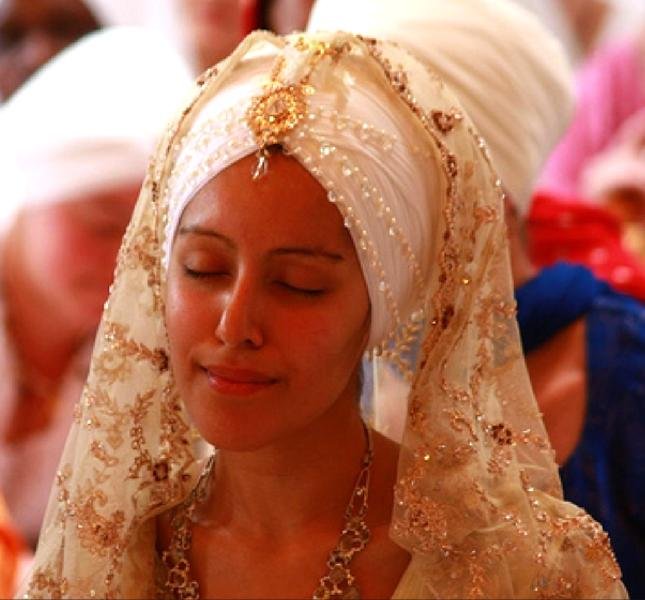
This very unique ceremony concludes with the Ardas of the Sangat which blesses the couple along with everyone gathered.
Again a vak is recited at random which gives a message for everyone assembled. Karah Prasad is distributed to all and the couple is garlanded with fragrant garlands and gifts are exchanged. The nearest and dearest also sprinkle flower petals on the couple and also a fresh garland is placed over the rumalla (dressing cloths) of the Sri Granth Sahib Ji. The relatives congratulate the parents of the couple and the celebration goes on.
At the end of the ceremony, everyone either moves into the Langar Hall for langar but in most cases, a reception is held elsewhere, and the party begins.
Those who value the real significance of the Aanad Karaj and Lavan are contented with the community langar (vegetarian meal) served in the Gurdwara. I have witnessed many Anand Karaj and have been particularly impressed with the organisation and preparation at Guru Nanak Sewak Jatha, Soho Road, Birmingham.
* In the context of Gurbani the Nau-Nidh or Nine Treasures come through the experience of Naam. They are:
1. Bharosa - faith. A deep and awareness of the presence of God.
2. Leenta - An absolute and deep attachment to the Infinite.
3. Santokh - Contentment
4. Non-attachment to family, friends and worldly possessions.
5. Hukam - Awareness of God's will and complete surrender to it.
6. Sehaj - Equilibrium and equipoise of the mind.
7. Anand - Perpetual delight and a deep sense of joy.
8. Vismaad - Ecstasy. The moment-to-moment awareness of Ang Sang Waheguru - the presence of God in every fibre and cell of one's body.
9. Nadar - Humility. The understanding that all blessings in one's life come by the Grace of God and not as a result of one's own efforts.
Acknowledgements: Beliefs and Practices by Owen Cole and Piara Singh Sambhi: The Sikhs: Faith, Philosophy & Folk by Sondeep Shankar and Gurbachan Singh; A Study of Sikhism by Dr Rani Kaur Vaid. Lavan translation and editing by Guruka Singh Khalsa. Photos by Gurumustuk Singh Khalsa.
Daljit Singh Boodar[email protected]
